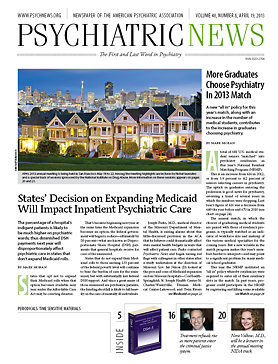The perpetration of homicide and other violence by people with mental disorders has been studied for decades, but the risk of such people being victims of homicide has received little attention. Researchers at Stanford University recently teamed with the Center for Primary Health Care Research at Lund University in Malmö, Sweden, to determine whether people with mental disorders are at an increased risk of being victims of homicide.
Casey Crump, M.D., Ph.D., lead author of the study and a clinical assistant professor in the Department of Medicine at Stanford School of Medicine, and colleagues performed a nationwide cohort study of all people aged 17 or older who were living in Sweden on January 1, 2001 (n=7,253,516), identifying 615 homicide deaths during eight years of follow-up, including 141 among people who had been diagnosed with a mental illness.
After adjusting for gender and age, having been diagnosed with any mental disorder was associated with more than a sevenfold risk of being a victim of homicidal death, compared with people without a mental disorder. The risk of homicidal death was strongest (approximately 16-fold higher risk) among those with substance use disorders, but it was also increased among those with personality disorders, depression, anxiety disorders, or schizophrenia and did not seem to be explained by comorbid substance use, the researchers noted.
Men had twice the risk of being victims of homicide, and the risk was more than twice as high among people who were divorced or never married, compared with those who were married or cohabitating. Other independent risk factors included low education level, low income, being unemployed, and living in large cities rather than in medium-sized cities or small towns.
The researchers noted that the homicide rate in Sweden (1.1 per 100,000 person years) is much lower than that of the United States (7.0 per 100,000 person years), and it is in the United States, they said, “where our findings are likely to have a larger public-health impact.”
In an accompanying editorial, a group from the Centre for Mental Health and Risk, part of the Institute of Brain, Behaviour, and Mental Health at the University of Manchester in Manchester, U.K., noted that the study had much valuable information to offer to clinicians. “A key implication of these new findings is that clinicians should assess risk for the full array of adverse outcomes that may befall people with mental health problems. This would include being a victim of violence as well as committing it, abuse and bullying, suicidal behavior, accidental drug overdoses, and other major adverse events linked with intoxication or impulsivity. These risks go together, and people with mental illness, as well as their families, should receive advice on avoiding various types of harm,” wrote Roger Webb, Ph.D., Jenny Shaw, Ph.D., and Louis Appleby, F.R.C.Psych. Webb is a senior research fellow in psychiatric epidemiology, Shaw is a professor of forensic psychiatry, and Appleby is a professor of psychiatry at the center.
Their editorial also pointed out future directions for further study, calling for direct comparison of patients’ risk of committing homicide with the risk of being a victim of it, as well as evaluation of how much of the risk of being a victim is a consequence of illness itself and therefore has the potential for prevention by mental health treatment. They also noted the need for analysis of the role hospitalization might play, saying “we know that discharged psychiatric patients and released prisoners are especially likely to take their own lives immediately after their return to the community. We need to know whether this heightened vulnerability on leaving institutional settings relates to being at risk from other people.”
The study was supported by grants from the National Institute on Drug Abuse, the Swedish Research Council, and the Anna Lindh Foundation. ■

